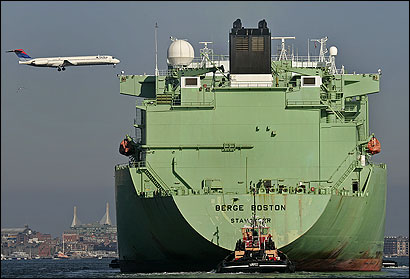Oil and gas, flooding the market. JD at Peak Oil Debunked updates the oil glut situation. 
GLUTS AND MORE GLUTS
Crude Oil At Sea Frustrates Efforts At Price Stability
Every time the oil market attempts to ignite a rally, an upsurge from the sea of crude stored on waterborne tankers snuffs it out.
The accumulation of oil held in "floating storage" gained speed in December, as available space in traditional onshore storage hubs dwindled due to the onslaught of excess supplies in the market. This floating storage is now among the biggest impediments to oil prices recovering any of the ground lost over the last six months. Companies are quick to sell cargoes at the hint of a turnaround in the oil market, unleashing a flood of oil onto a near-saturated landscape.
More oil is being produced than recession-stricken economies need, and oil prices have fallen as the extra crude fills storage terminals worldwide. Crude futures prices are down more than 70% from all-time record highs hit in July 2008. Light, sweet crude oil for March delivery on Tuesday settled 46 cents, or 1.1%, lower at $40.32 a barrel on the New York Mercantile Exchange.
The oil sitting at sea adds an extra layer of uncertainty about the extent of the supply overhang, which traders say must be whittled down for oil prices to rebound.
Tankers carrying up to 2 million barrels each are not counted in government inventory statistics, but can deliver their cargoes anywhere in the world. Ship trackers estimate that up to 80 million barrels may be on the water, or more than twice the amount kept in Cushing, Okla., the largest commercial storage center in the U.S.
An LNG glut seems to be brewing as well. Hate to be repetitive, but whatever happened to that imminent cliff in natural gas that Matt Simmons was hysterically squealing about 6 years ago? With rising domestic production from shale and other unconventional natural gas plays, and now a surge of LNG, we seem to be swimming in the stuff.
Natural gas glut could hit U.S.
As many as seven massive natural gas export terminals are expected to start up overseas this year, expanding worldwide capacity by 20 percent and flooding markets with new supplies of the key power plant and heating fuel. Dozens of new tankers capable of carrying natural gas in a liquefied form are slated to hit the seas.
Just as these new supplies come on line, worldwide demand is expected to drop as the global recession deepens.
Operators of these new facilities are unlikely to cut back production, however, so shipments of liquefied natural gas will most likely head to the deepest markets with the greatest amount of natural gas storage capacity — the United States.

‘Counterintuitive’
“It’s completely counterintuitive,” said Murray Douglas, a global LNG analyst with Wood Mackenzie in Houston, who is predicting U.S. LNG imports will grow 30 percent to 456 billion cubic feet this year and to more than 1.1 trillion cubic feet by 2013.
“We don’t believe Asia and Europe will be in a position to absorb this new production, and the U.S. is the only market that can take it, that has a large amount of storage.”
The wave of imports might even be strong enough to challenge growing domestic natural gas production from various shale formations, including the Barnett Shale near Fort Worth and Fayetteville Shale in Arkansas.
“This can put pressure on U.S. gas prices and could delay the full development of some of the new shale projects,” Douglas said.
Other analysts, including Houston-based Waterborne Energy and Raleigh, N.C.-based Pan Eurasia Enterprises, agree that an American gas import surge may be coming.
Even the Department of Energy updated its LNG import predictions for 2009 recently to include the possibility of such a surge.


